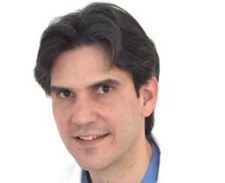Cuban-American Eases Pain — and Doctor Shortage
Date: February 27, 2017
On a recent Monday at the Vital Pain Center in Pittsburgh, a $700,000 business that serves some 1,500 patients, a patient asked Dr. Jorge Rivero-Becerra for clearance to start playing hockey again. Rivero-Becerra was happy to give him the OK to hit the ice. “It’s really rewarding to help people who are suffering, to help them get better and go back to being productive and happy,” Rivero-Becerra says.

A Cuban immigrant, Rivero-Becerra is grateful that his family moved to the United States when he was a teenager. In Cuba, he didn’t even feel free to speak his own mind, much less pursue his life’s calling. “It was very oppressive. There was no freedom of speech, and it was dangerous to not agree with the government,” he says.
Rivero-Becerra arrived here in 1994 at the age of 17. Nights he studied English and earned his high-school equivalency diploma; days he worked odd jobs, painting buildings, working in a pet store. After only six months, he was admitted to the City College of the City University of New York. The low tuition rate meant that he was able to finance his education with his wages and some help from his mother. Rivero-Becerra gained admittance to Icahn School of Medicine at Mt. Sinai School of Medicine and completed his medical residency at Columbia University.
“I was lucky in a way. When I came to United States, I had a clear objective. I knew I wanted to be a doctor, so there was very little chance of derailment. I just kept my head down,” he says.
Rivero-Becerra’s drive has also benefitted an adopted country in need of physicians. A 2016 study by the American Association of Medical Colleges projected that by 2025 the United States will be short 60,000 to 95,000 doctors. As the population ages, immigrants like Rivero-Becerra are critical to ensuring that Americans receive the care they need. According to data from New American Economy, immigrants are twice as likely as native-born Americans to fill high-skill healthcare positions as physicians and surgeons. They are also twice as likely to take low-skill heath care jobs like those as home health aides.
If you’re doing the right thing, working and being productive, you should be given a chance. We need doctors, nurses. We need people working.
At Vital Pain Center, a solo practice with three fulltime workers, all of whom were born in America, Rivero-Becerra treats many people who are over 50 and suffering from spinal pain. He enables his patients not only to resume their favorite sports and pastimes, but also to return to work and daily life without pain. “Cooking, cleaning, going shopping — these are things we take for granted. Just getting out of bed in the morning and going to the bathroom. If you take that pain away, it makes a huge difference in people’s lives,” he says.
Rivero-Becerra is grateful for the opportunity to use his talents and to live in a country where he can chart his own course. “I have lived in a lot of different neighborhoods: Hispanic, black, white, rich, poor,” he says. “When American people see that you have a mission, they appreciate that. They respect you. If you’re Latino, Chinese, I don’t think people really concern themselves about that. What they really want is to see people who are driven, who want to do something with their lives.”
He believes that other people who want to come to this country and contribute should have this opportunity, too. He especially wants to see immigration reform that gives medical professionals the ability to come and serve American communities. “If you’re committing crimes, this is not the right place for you — no place is the right place for you,” he says. “But if you’re doing the right thing, working and being productive, you should be given a chance. We need doctors, nurses. We need people working.”
